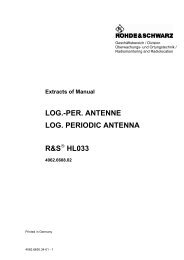Glossary of Video Terms and Acronyms - Isotest
Glossary of Video Terms and Acronyms - Isotest
Glossary of Video Terms and Acronyms - Isotest
Create successful ePaper yourself
Turn your PDF publications into a flip-book with our unique Google optimized e-Paper software.
<strong>Video</strong> <strong>Terms</strong> <strong>and</strong> <strong>Acronyms</strong><br />
<strong>Glossary</strong><br />
Color Black – A composite video signal that produces a black screen<br />
when viewed on a television receiver.<br />
Color Burst – a) The portion <strong>of</strong> a color video signal that resides on the<br />
backporch between the breezeway <strong>and</strong> the start <strong>of</strong> active video that contains<br />
a sample <strong>of</strong> the color subcarrier used to add color to a signal. It is<br />
used as a color synchronization signal to establish a reference for the color<br />
information following it <strong>and</strong> is used by a color monitor to decode the color<br />
portion <strong>of</strong> a video signal. The color burst acts as both amplitude <strong>and</strong> phase<br />
reference for color hue <strong>and</strong> intensity. The color oscillator <strong>of</strong> a color television<br />
receiver is phase locked to the color burst. b) A nine-cycle-NTSC<br />
burst <strong>of</strong> color subcarrier which is imposed on blanking after sync. Color<br />
burst serves as the reference for establishing the picture color.<br />
Color Coordinate Transformation – Computation <strong>of</strong> the tristimulus values<br />
<strong>of</strong> colors in terms <strong>of</strong> one set <strong>of</strong> primaries from the tristimulus values <strong>of</strong><br />
the same colors in another set <strong>of</strong> primaries. Note: This computation may be<br />
performed electrically in a color television system.<br />
Color Correction – a) A process by which the coloring in a television<br />
image is altered or corrected electronically. Care must be taken to ensure<br />
that the modified video does not exceed the limits <strong>of</strong> subsequent processing<br />
or transmission systems. b) The adjustment <strong>of</strong> a color reproduction<br />
process to improve the perceived-color conformity <strong>of</strong> the reproduction to<br />
the original.<br />
Color Decoder – A device that divides a video signal into its basic color<br />
components. In TV <strong>and</strong> video, color decoding is used to derive signals<br />
required by a video monitor from the composite or Y/c.a. signals. See<br />
Chroma Demodulators.<br />
Color Demodulator – See Chroma Demodulators.<br />
Color Difference Signals – Signals used by color television systems to<br />
convey color information (not luminance) in such a way that the signals go<br />
to zero when there is no color in the picture. Color difference signal formats<br />
include: R-Y <strong>and</strong> B-Y; I <strong>and</strong> Q; U <strong>and</strong> V; PR <strong>and</strong> PB . The figure below<br />
shows general color difference waveforms along with the Y signal. The<br />
color difference signals must first be converted in their RGB form before<br />
they can recreate the picture. Refer to the RGB discussion to view what the<br />
RGB version <strong>of</strong> the color bar signal looks like. The color difference signals<br />
in the figure are centered around 0 volts, but this is only true for the<br />
SMPTE/EBU N10 st<strong>and</strong>ard. The NTSC <strong>and</strong> M11 color difference st<strong>and</strong>ards<br />
have the most negative portions <strong>of</strong> the color difference signals riding on a<br />
voltage <strong>of</strong> 0 volts or close to it.<br />
Color Edging – Spurious colors appearing along the edges <strong>of</strong> color pictures,<br />
but that do not have a color relationship to the picture.<br />
34 www.tektronix.com/video_audio<br />
Y P B, B-Y, V or Q P R, R-Y, U or I<br />
Color Encoder – Performs the reverse function <strong>of</strong> the chroma demodulator<br />
in that it combines the two color difference signals into the single chroma<br />
signal.<br />
Color Frame – a) In NTSC color television, it takes four fields to complete<br />
a color frame. In PAL, it takes eight fields. b) Polarity <strong>of</strong> the video frame.<br />
Color frame must alternate polarity with each frame to keep the video signal<br />
in phase.<br />
Color Frame Timed – See the Color Framed discussion.<br />
Color Framed – Two signals are said to be color framed at a switcher or<br />
router when their field 1, line 10 events (field 1, line 7 in PAL) occur at the<br />
same time at the input to the switcher or router. To prevent picture distortions<br />
when changing signals at a switcher or router, the signals must be<br />
color framed.<br />
Color Gamut – In a system employing three color primaries to encode<br />
image color, each primary can be located on a CIE chromaticity diagram<br />
<strong>and</strong> these points connected as a plane figure. If the apexes are then connected<br />
with an appropriate value on the white point axis, a so) id figure is<br />
produced enclosing the color gamut for that system. (On the CIE chromaticity<br />
diagrams, the points in x, y, z space approximate an inverted tetrahedron.<br />
In u, v, w space, they become a somewhat irregular four-cornered<br />
solid.) Colors within the color gamut solid volume can be reproduced by the<br />
system as metameric matches. Colors outside the color gamut solid volume<br />
cannot be matched. Note: The area <strong>of</strong> the cross-section from the color<br />
gamut solid is a function <strong>of</strong> the luminance. Although it is advantageous to<br />
have the widest possible color gamut for the ability to provide metameric<br />
matches for the largest number <strong>of</strong> colors, the required transformations<br />
from origination colorimetry to colorimetry matched to available display primaries,<br />
for example, may require large matrix coefficients <strong>and</strong>, therefore, a<br />
signal-to-noise penalty. The choice <strong>of</strong> color gamut is a compromise<br />
between color rendition <strong>and</strong> signal-to-noise.<br />
Color Key – See Chroma Key.<br />
Color Killer – Circuitry which disables the receiver’s color decoder if the<br />
video does not contain color information.<br />
Color Lookup Table (CLUT) – The CLUT is a compression scheme where<br />
pixel values in the bitmap represent an index into a color table where the<br />
table colors have more bits-per-pixel than the pixel values. In a system<br />
where each pixel value is eight bits, there are 256 possible values in the<br />
lookup table. This may seem a constraint but, since multiple lookup tables<br />
can be referenced, there can be many tables with varying 256 color<br />
schemes. CLUTs work best for graphics where colors do not have to be<br />
natural.<br />
Color Map – A color map is just a numbered list <strong>of</strong> colors. Each color is<br />
specified in terms <strong>of</strong> its red, green, <strong>and</strong> blue components.<br />
Color Map Animation – In normal animation, the images representing<br />
separate frames are written on separate pieces <strong>of</strong> artwork. In computer<br />
color map animation, many images can be written into a frame buffer, each<br />
with a different color number. By “cycling” white, for example, through the<br />
color map, so that only one image at a time is visible, the illusion <strong>of</strong> animation<br />
can be achieved very quickly. PictureMaker’s wireframe test mode<br />
works this way.





